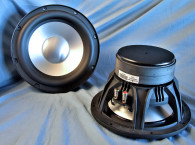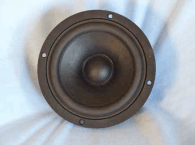


Wavecor’s SW168WA01, available only as a 4 Ω model, has a generous feature set that includes a proprietary four-spoke stamped steel frame that is substantially open below the spider mounting shelf due to the eight 15 mm × 8 mm rectangular vents. Other features include the incorporation of a very stiff flat black curvilinear paper cone, further stiffened by a 2” convex black paper dust cap. Suspension is provided by a low-loss (high Qm) NBR rubber surround plus a 3.25” diameter black flat Conex spider (damper).
All this is driven by a 32 mm diameter (1.26”) voice coil wound with round wire on a black fiber glass non-conducting former. The motor system powering the cone assembly utilizes two 13 mm thick, 89 mm diameter ferrite magnets sandwiched between a black plated 4 mm thick front plate and a black plated and shaped T-yoke that has a 11 mm diameter pole vent that is flared at both ends to suppress vent noise.
As part of Wavecor’s Balanced Drive motor format, the SW168WA01 further incorporates an aluminum shorting ring (Faraday shield) that reduces distortion caused by eddy currents. Last, the braided voice coil lead wires terminate to a pair of gold terminals.



I began characterizing the SW168WA01 6.5” subwoofer using the LinearX LMS analyzer and VIBox to measure both voltage and admittance (current). Sweeps were generated in free-air at 0.3, 1, 3, 6, 10, and 15 V. The Wavecor-provided measured Mmd (an actual physical cone assembly measurement with 50% of the surround and spider removed) was used rather than a single 1 V added (delta) mass measurement. It should also be noted that this multi-voltage parameter test procedure includes heating the voice coil between sweeps for progressively longer periods to simulate operating temperatures at that voltage level (raising the temperature to the first and second time constants).
I discarded the 15V curves because by that voltage level the SW168WA01 was nonlinear enough in free air to prevent LEAP 5 from getting a successful curve fit. I further processed the remaining 10 sine wave sweeps for each woofer and divided the voltage curves by the current curves to produce impedance curves. I generated the phase curves using the LEAP phase calculation routine, and then copy/pasted the impedance magnitude and phase curves plus the associated voltage curves into the LEAP 5 Enclosure Shop software’s Guide Curve library. Next, I calculated the parameters, using the LEAP 5 LTD transducer model.
Because most manufacturing data is produced using either a standard transducer model or the LEAP 4 TSL model, I also generated LEAP 4 TSL model parameters using the 1 V free-air that can also be compared with the manufacturers data. Figure 11 shows the SW168WA01’s 1 V free-air impedance plot. Table 1 compares the LEAP 5 LTD and LEAP 4 TSL Thiele-Small (T-S) parameter sets for the two SW168WA01 driver samples along with the Wavecor factory data.
From the comparative data shown in Table 1, you can see that all four parameter sets for the two samples were reasonably similar and correlated reasonably well with the factory data. The Fs/Qt ratios are close enough to produce a box simulation with the factory data that had less than 0.5 dB variation from my data. However, following my normal protocol for Test Bench testing, I used the sample 1 LEAP 5 LTD parameters and set up two computer enclosure simulations, one in a 0.3 ft3 QB3 vented enclosure with 15% fill material (fiberglass) tuned to 37 Hz; and for the second example, a 0.75 ft3 ported box also with 15% fill material and tuned to 38 Hz.
Figure 2 gives the results in the smaller and larger vented enclosures at 2.83 V and at a voltage level sufficiently high enough to increase cone excursion to Xmax + 15% (8 mm for SW168SW01). This resulted in a F3 of 55 Hz (-6 dB = 45 Hz) for the QB3 vented enclosure and a -3 dB for the larger vented simulation of 38 Hz (-6 dB = 44 Hz). Increasing the voltage input to the simulations until the approximate Xmax +15% maximum linear cone excursion point was reached resulted in 108 dB at 24.5 V for the smaller enclosure simulation and 101 dB with a 20V input level for the larger box. Figure 3 shows the 2.83V group delay curves. Figure 4 shows the 24.5 V/20 V excursion curves.




Klippel analysis for the SW168WA01 produced the Klippel data graphs shown in Figures 5-8. (Our analyzer is provided courtesy of Klippel GmbH and the analysis was performed by Patrick Turnmire, Redrock Acoustics. Please note, if you do not own a Klippel analyzer and would like to generate this type of data on any transducer, Redrock Acoustics can provide Klippel analysis of most any driver. Visit www.redrockacoustics.com for more information.)
The Bl(X) curve, shown in Figure 5 is moderately broad and mostly symmetrical typical (with a bit of offset and “tilt”) of a driver with a relatively high Xmax (7 mm is a lot of Xmax for a 6.5”). For the Bl symmetry curve shown in Figure 6, there is about 2 mm Bl coil-out (forward) offset once you reach an area of reasonable certainty (5 mm), decreasing to 1.68 mm at the physical 7 mm Xmax position, and decreasing beyond that point.
Figure 7 and Figure 8 show the Kms(X) and Kms symmetry curves. Like the Bl curve, the KMS stiffness of compliance curve shown in Figure 7 is even more symmetrical, with minor offset. The Kms symmetry range curve shown in Figure 8 has a minor 1.14 mm coil-out (forward) offset at a region of certainty (6 mm) that decreases to 1 mm by 8 mm.


Figure 9 gives the inductance curve Le(X) for this transducer. Motor inductance will typically increase in the rear direction from the zero rest position as the voice coil covers more of pole; however, that doesn’t happen here. What we do get is lower inductance variation from full in to full out travel, which the goal you want to achieve. The aluminum shorting ring is doing its job with inductance only varying about 0.1 mH from -7 mm to +7 mm, which is reasonably minimal inductance change.
After the Klippel analysis was finished, I mounted the driver in an enclosure filled with foam damping material and that had a 15” × 9” baffle area and proceeded to measure the SW168WA01’s SPL on and off axis, using the LMS gated sine wave technique. Figure 10 gives the on-axis response measured 300 Hz to 20 kHz at 2.83 V/1 m. The response has a 6 dB peak at 1 kHz, with a breakup mode peak up 5 dB at 5.4 kHz. The on and off-axis to 45° is displayed in Figure 11, with the normalized response shown in Figure 12. Even though the SW168WA01 is a subwoofer, it would be possible to use it in a three-way configuration with a low-pass crossover frequency as high as 3 kHz to a midrange driver and tweeter, or as a two-way to a large planar transducer. However, that would mean dealing with the peaking at 1 kHz, which is possible both actively and passively. However, I would probably not cross it any higher than 700 to 800 Hz using, for example, a midrange dome and tweeter. Since there is not much directivity change at this low a frequency, I skipped the CLIO polar plot for this driver. Figure 13 gives the two sample SPL comparison showing, as you would expect from Wavecor, the drivers to be well matched.




Next, I used the Listen SoundConnect analyzer to perform distortion and time domain analysis. I set the voltage level with the driver rigidly mounted in free air and increased the voltage until it produced a 1 m SPL of 94 dB (6.2 V), which is my SPL standard for home audio drivers. I placed the microphone near-field about 10 cm from the dust cap. This plot is shown in Figure 14. As can be seen, this actually includes two plots, the top graph being the standard fundamental SPL curve with the second and third harmonic curves, and the bottom graph shows the second and third harmonic curves plus the total harmonic distoriton (THD) curve with an appropriate X-axis scale. Interpreting the subjective value of conventional distortion curves is almost impossible. However, looking at the relationship of the second to third harmonic distortion curves is of value. I used SoundCheck 15 to get a 2.83 V/1 m impulse response (again mounted in the enclosure with the 15” × 9” baffle) and imported the data into Listen’s SoundMap Time/Frequency software. Figure 15 shows the resulting CSD waterfall plot. Figure 16 shows the Wigner-Ville plot.
As I have said in previous Wavecor explications, I have used Wavecor drivers (both off the shelf and with proprietary modifications) on several projects as a consultant, and have a lot of respect for this China-based company. The SW168WA01 is another well crafted transducer from the engineers at Wavecor. For more information, visit www.wavecor.com. VC


This article was originally published in Voice Coil, July 2017.







